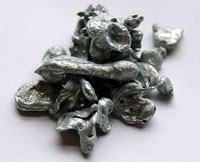An important quality of zinc is its ability to resist corrosion and therefore protect other metals. Half of all zinc produced today is used to galvanize steel to prevent against corrosion. It is used to protect buildings, cars, nails, wire, pipes and more.
Zinc compounds such as zinc oxide are found in many common commercial products, including batteries, paint, plastics, rubber products, pharmaceuticals, floor coverings, inks, cosmetics, soap, and textiles. Zinc is also a natural insect repellent and sun screen, helping to protect our skin.
Foods that are a great source of zinc include lean red meats like beef, lamb and liver and seafood such as oysters and lobster. Whole grains, seeds, beans, nuts, and almonds are all good sources if grown in zinc rich soil.
Even though zinc is an essential requirement for good health, excess zinc can be harmful, suppressing copper and iron absorption. The U.S penny coin is made of 97.5% zinc and there have been cases of zinc toxicity after humans and dogs ingested the coins.
| | | 
| | More Metal Facts: | | | | | | | | | | | | | Zinc Facts |
|